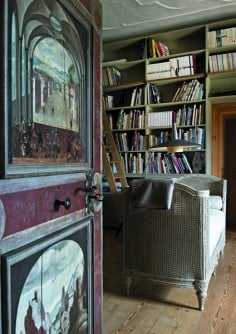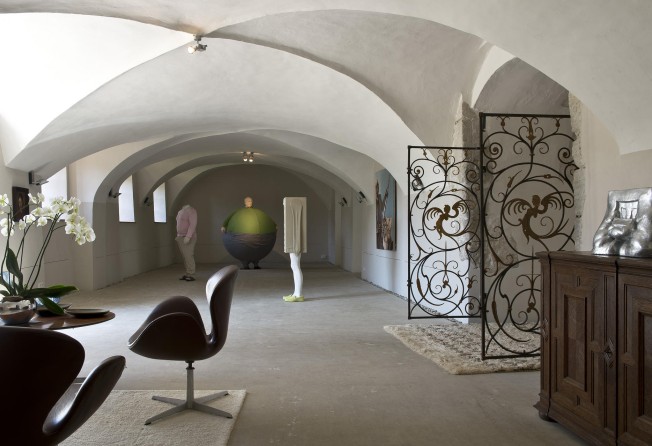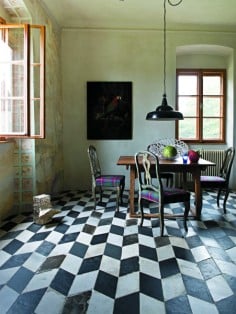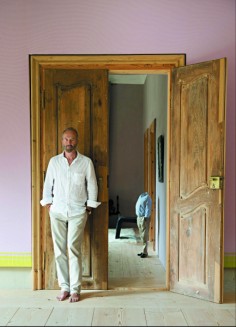
Inside the home of Erwin Wurm - The Artist Who Swallowed the World
Artist-sculptor Erwin Wurm 'fell in love' with the castle he restored to its former renaissance glory

SPECCHECK
Residents:
Erwin Wurm, his wife Elise and their three-year-old daughter Estée. Animals on the estate include a dog, some sheep, a turkey, chickens, a turtle in the lake, frogs and hunting birds.
Location:
The Castle of Limberg, about 40 minutes northwest of Vienna
Claim to fame:
Known for his humorous take on formalism, the multidisciplinary artist is best known for his one-minute sculptures, which are improvised and crafted with whatever objects, participants and backgrounds are available on the spot. His whimsical, eccentric works include inflated sculptures such as The Artist Who Swallowed the World and Fat Car.

Those lucky enough to have met the author and man behind Erwin Wurm: The Artist Who Swallowed The World will know that ingesting a planet doesn't seem to have weighed the man down much. With his ever humorous and artistic eye, he has created a home filled with art, life and, undoubtedly, laughs.
The affair began more than a decade ago. While Wurm previously had a "beautiful old house" in the neighbourhood, he had his eyes and heart set on Austria's Limberg Castle.
"Every time I picked someone up from the train [station] … I passed by Limberg," Wurm says. "[I] immediately fell in love with the beautiful estate and house."
And who can blame him? The estate, with its baroque build and plush greenery, is certainly inspiring and has a rich history to match. With a history dating back to the 12th century, the castle originally belonged to an Austrian aristocratic family, and was later given as a gift to the German monastery Stift Altenburg. The monastery kept it for 150 years, before the sculptor finally made it his family home and studio.
While the exterior won over Wurm from early on, he was initially less than thrilled about the interiors. "The house looked very strange," he recalls of the estate when he first purchased it. "The monastery had built apartments into the old castle. They restructured the rooms by dividing the big halls and building several rooms into the big halls."

Undeterred, the artist set out to restore the house to its former renaissance glory.
"I quickly realised that the house needed to breathe again," Wurm says. To achieve the bright and spacious home he wanted, the artist deconstructed the small rooms and brought the house back to its "original baroque structure".
The deconstruction opened up the château, bringing with it an abundance of natural light which illuminates the airy rooms, which became one of the many charms of the estate that Wurm appreciates. "I get up with the sun in the bedroom," he says. "Then I move with the sun around the house." As he chases the beautiful natural light streaming into his home, he is enveloped by a perfect blend of vintage and modern furniture and art pieces.
"Setting the furniture [around the estate] was like installing a show," Wurm says. While the designer says the design process happened naturally as he was merely "working with [his] intuition", the final product echoes the messages and emotions evoked in many of his art pieces.

In one of the living rooms, for example, his famous Fat Car sculpture, a plumped up version of a Porsche in eye-catching neon pink, sits atop a Venetian baroque table. In another room, a gothic statue originally part of a French cathedral stands next to Wurm's own Small Silver House II, which he created in 2012.
This dichotomy of eras and design aesthetics, which works beautifully together with an extraordinarily elegant harmony, is reflected throughout the beautiful estate.
"I like the conversation between tradition and avant-garde," Wurm explains of the seemingly confusing pairings of furnishings. It was important to the artist to not only restore the estate to its original architectural order, but also to add strong contemporary voices and elements.
And what contemporary voice would be better than his own? To step into Wurm's house is to enter his whimsical world. Scattered across the estate, from the garden to little nooks and crannies in the house, one will find gems of his artworks.

Obvious pieces, such as The Artist Who Swallowed The World and Anger Bump, greet guests as they enter the home through a set of renaissance grill gates. More subtle pieces include miniature sculptures, such as Small Silver House and Suit (Philosophers), and other whimsical figurines.
His works extend beyond his sculptures. In the dining room, casually placed on a sideboard among framed photos is a table lamp created by Wurm as part of his furniture collection. And in the living areas, family and friends can lounge comfortably on the sofa or chairs, also created by the multidisciplinary artist and designer.
While the artist says restoring a house is in no manner similar to his artistic creations, one look around his estate and you might beg to differ.
Wurm has a knack of pairing objects which aren't necessarily a natural match and this innate talent is rightly celebrated. It is certainly evident throughout his artistic, beautifully designed home.